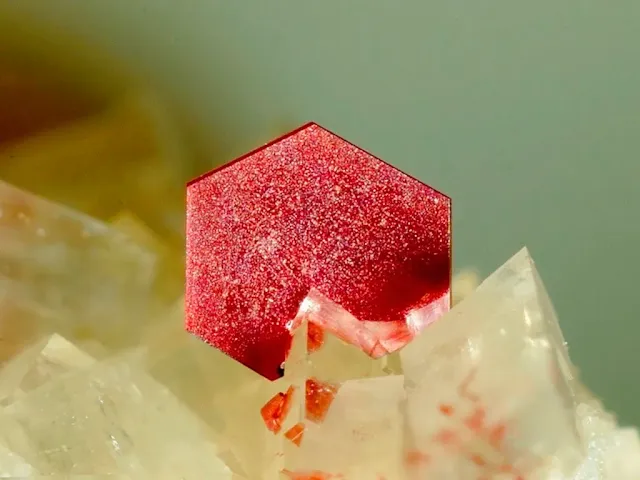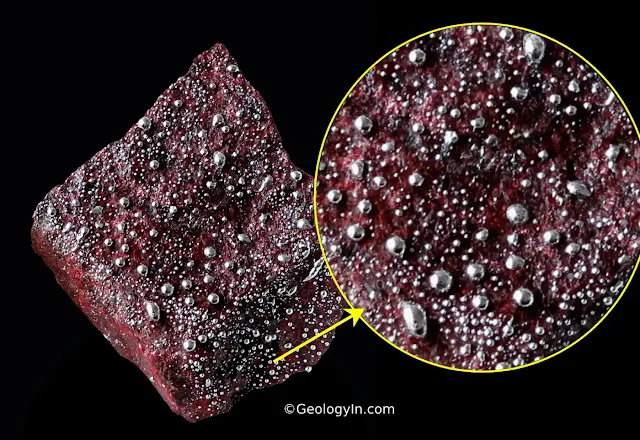Cinnabar: The Beautiful, Toxic Mineral
Cinnabar is a bright red mineral consisting primarily of mercuric sulfide. It is the principal ore from which mercury is extracted. Its vibrant red color has also made it a popular pigment throughout history.
What is cinnabar?
Cinnabar is a bright red to reddish-brown mineral composed of mercury sulfide (HgS), which is the primary ore of mercury. It is known for its striking red color and has historically been used as a pigment in art and as a source of mercury for various purposes, including in traditional medicines and alchemy. However, due to its toxic nature, the use of cinnabar and mercury derived from it has declined in modern times.
Cinnabar is found worldwide, but some of the most notable deposits are in Almadén, Spain, where it has been mined for over 2,000 years. Due to its toxic nature, cinnabar mining is no longer as common today, and safer alternatives have been found for the purposes it was historically used for.
Formation of Cinnabar
How is cinnabar formed? Cinnabar forms through hydrothermal processes, involving the following steps:
Geothermal Activity: Cinnabar is typically found in areas with significant geothermal activity, such as volcanic regions or areas with hot springs.
Hydrothermal Fluids: Cinnabar forms from hydrothermal solutions, which are hot, aqueous fluids circulating through the Earth's crust. These fluids often contain high concentrations of mercury and sulfur.
Temperature and Pressure Conditions: Under specific conditions of temperature and pressure, mercury (Hg) and sulfur (S) in the hydrothermal fluids combine to form mercuric sulfide (HgS).
Precipitation: As the hydrothermal fluids cool, cinnabar precipitates out of the solution and is deposited in veins or disseminated through the host rock.
Associated Minerals: Cinnabar is often found alongside other minerals such as quartz, calcite, barite, and various sulfides.
Geological Settings
Cinnabar deposits are typically found in:
- Volcanic Regions: Areas with past or present volcanic activity.
- Fault Zones: Regions with significant faulting and fracturing, which provide pathways for the hydrothermal fluids.
- Hot Springs: Locations where hot springs are present, indicating geothermal activity.
 |
| Cinnabarite crystal from Giovanni Mine, Bindua, Iglesias, South Sardinia Province, Sardinia, Italy. Photo: Enrico Bonacina |
Cinnabar Properties
Composition: Cinnabar, also known as mercury sulfide, has a chemical composition represented by the formula HgS.
Cinnabar Physical Properties
- Color: Cinnabar exhibits a distinctive bright red to brownish-red color, which is one of its most characteristic features. This coloration is due to the presence of mercury.
- Transparency: It can range from transparent to translucent, though larger crystals or massive forms may appear opaque.
- Luster: Cinnabar typically displays an adamantine to dull luster.
- Crystal System: It crystallizes in the trigonal system, often forming rhombohedral or tabular crystals.
- Streak: The streak of cinnabar is scarlet.
- Hardness: On the Mohs scale, it has a hardness of 2-2.5, making it quite soft and easily scratched.
- Cleavage: It exhibits perfect cleavage on {101̅0}, which means it can be easily split into thin, flat sheets.
- Fracture: The fracture of cinnabar is uneven to subconchoidal, meaning it breaks with irregular or somewhat curved surfaces.
- Habit: Cinnabar forms as prismatic, Rhombohedral, and tabular crystals, massive veins, botryoidal clusters, granular aggregates, or fine red powder.
- Density: With a density of 8.1 g/cm³, cinnabar is relatively heavy due to its mercury content.
- Tenacity: It is sectile, meaning it can be cut with a knife and produces a slightly malleable or pliable surface when cut.
- Solubility: Cinnabar is insoluble in water but decomposes in acids, releasing hydrogen sulfide gas (H₂S).
- Magnetism: It is non-magnetic.
Cinnabar Optical Properties
- Fluorescence: Cinnabar does not exhibit fluorescence under ultraviolet light.
- Pleochroism: There is weak pleochroism in cinnabar, where the mineral may show different shades of red or yellow-red when viewed from different angles.
- Refractive Index: The refractive indices are n_ω = 2.905 and n_ε = 3.256, indicating its optical properties under specific light conditions.
 |
| Botryoidal Cinnabar cluster. |
Cinnabar Occurrence
Where is cinnabar found? Here are some key locations where cinnabar is commonly found:
Spain: Notably in Almadén, which historically has been one of the largest sources of cinnabar. The Almadén mines have been known since ancient times and were a major source of mercury.
China: Significant deposits are found in several provinces including Hunan, Guizhou, and Yunnan. The province of Guizhou is particularly known for producing high-quality cinnabar.
Mexico: Important cinnabar deposits are found in regions such as Huancavelica and San Luis Potosí.
United States: Occurrences are noted in California (e.g., the Clear Lake region), Nevada, Texas, and Alaska.
Peru: Cinnabar is found in notable quantities in the Huancavelica region.
Italy: Deposits are known from regions like Tuscany and Sicily.
Kyrgyzstan: Cinnabar occurrences have been reported in the Central Asian country.
Russia: Deposits have been documented in the Ural Mountains.
 |
| Cinnabar crystals are aesthetically scattered on matrix inside Almaden mine, Almaden District, Ciudad Real, Castile-La Mancha, Spain |
Uses of cinnabar
Cinnabar has been used historically and continues to be utilized in various ways despite its toxicity. Here are some of the primary uses of cinnabar:
Pigment (Vermilion): One of the most significant historical uses of cinnabar is as a bright red pigment known as vermilion. It has been used in painting, lacquerware, ceramics, and other arts since ancient times. Vermilion made from cinnabar was highly valued for its intense color and durability.
Mercury Ore: Cinnabar is the primary ore of mercury (Hg). When heated, cinnabar decomposes and releases mercury vapor, which is then condensed and collected. Mercury obtained from cinnabar has been used in various industrial processes, including thermometers, barometers, batteries, and in the production of chlorine and caustic soda.
Traditional Medicine: In some cultures, cinnabar has been used in traditional medicine despite its toxicity. It was believed to have healing properties and was used in small quantities under careful administration. However, due to its mercury content, its medicinal use is highly discouraged today.
Cosmetics: In various cultures, powdered cinnabar was used as a rouge-like cosmetic for thousands of years. Again, due to health concerns, this practice is no longer recommended.
Spiritual and Ceremonial Uses: Cinnabar has been associated with spiritual and ceremonial practices in certain cultures. It was sometimes used in rituals or as a symbol of vitality and transformation.
Decorative Objects: Cinnabar has been used to create decorative objects such as carvings, beads, and ornaments due to its vibrant color and relative softness, which allows for carving and shaping.
 |
| Cinnabar crystals on dolomite from Hunan, China. |
Is Cinnabar Toxic or Dangerous
Yes, Cinnabar is toxic and considered dangerous due to its high mercury content. Mercury sulfide, the primary component of cinnabar, can release toxic mercury vapors when handled, crushed, or heated. Inhalation of these vapors can cause acute poisoning, leading to symptoms such as tremors, muscle weakness, and cognitive impairment.
Ingesting cinnabar is also harmful because mercury in the mineral can convert to methylmercury in the digestive system. Methylmercury is easily absorbed into the bloodstream and can cause systemic toxicity.
While less common, prolonged skin contact with cinnabar can lead to mercury absorption, although this route of exposure is generally less significant than inhalation or ingestion.
When handling cinnabar, caution is crucial, especially during heating or processing, as this can release mercury vapors or dust particles. It's important to avoid direct contact and inhalation of cinnabar dust to prevent exposure to mercury.
In its natural mineral form, cinnabar is generally stable and not immediately hazardous unless disturbed. However, due to the potential for releasing mercury, careful handling is necessary.
If there are concerns about exposure to cinnabar, seeking advice from a health professional or toxicologist is recommended.
 |
| Cinnabar Pigment |
Interesting Facts About Cinnabar
- Cinnabar is still mined today, but its use is much more limited due to concerns about its toxicity. It is primarily used in the production of mercury for industrial applications.
- Interestingly, cinnabar is the most common and significant ore of mercury, containing mercury in its natural state. While there are other mercury-bearing minerals, they typically form through the weathering or alteration of cinnabar.
- Despite its toxicity, cinnabar was once believed to have a number of medicinal properties. It was used to treat a variety of ailments, including syphilis, epilepsy, and skin diseases.
- Vermilion pigment can also be synthesized artificially by reacting mercury with sulfur. This synthetic vermilion has similar properties to the natural pigment and has been used in art and industry.
- The streak of cinnabar is scarlet, which distinguishes it from similar-colored minerals like realgar or cuprite.
 |
| Dark red cinnabar matrix coated on all surfaces with small droplets of liquid mercury. Photo: Viamineralia |
Cinnabar FAQs
How is cinnabar processed to extract mercury?
Mercury is extracted from cinnabar by heating the ore in a furnace. The heat causes the mercury sulfide to decompose into mercury vapor and sulfur dioxide gas. The mercury vapor is then condensed into liquid mercury.
Medical Use of Cinnabar
Historically, cinnabar was used in traditional Chinese medicine and other ancient medicinal practices. It was believed to have various benefits, including calming the spirit, treating insomnia, and detoxifying the body. However, due to the high toxicity of mercury, its use in modern medicine is obsolete and discouraged. The risks associated with mercury poisoning far outweigh any perceived benefits, leading to its decline in medicinal use.
 |
| Lustrous Cinnabar on Dolomite, from Chatian Mine, Hunan Province China Photo by: Fabre Minerals |
Is cinnabar a real gem?
Technically, no. While cinnabar is a beautiful red mineral sometimes used in carvings and jewelry, it's not considered a true gemstone. This is because it's relatively soft and quite toxic. Many gem dealers sell a substitute made of resin, which is safe and more durable.
Why is it called cinnabar?
The name "cinnabar" derives from the Ancient Greek word "κιννάβαρι" (kinnabari), which referred to both the red mineral and the associated pigment. This term likely has origins in the Persian word "zinjifrah" (زِنْجِفْرَ), meaning "dragon's blood." The term emphasizes the mineral's vivid red color, which has been associated with blood and life force in many cultures.
What are the other names for cinnabar?
Other Names for Cinnabar
- Mercurblende: This is a less common name for cinnabar that refers to its chemical composition (mercury sulfide).
- Cinnabarite: This is a more scientific name for cinnabar.
- Vermilion: This is the most common name for the bright red pigment made from cinnabar. Vermilion was the most widely used red pigment for centuries until the development of synthetic alternatives in the 20th century.
- Hypercinnabar: This is a rare, high-temperature form of cinnabar that is black.
- Metacinnabar: This is a black, synthetic form of cinnabar.


%20(1).webp)






